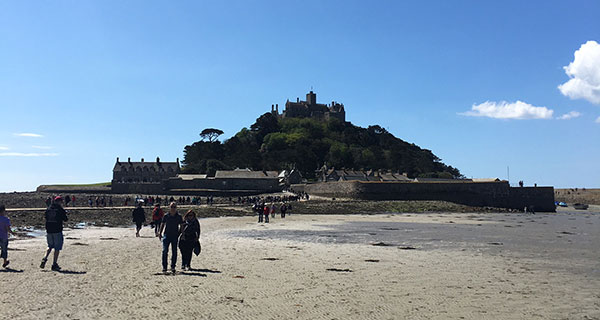- Looking for the Pirates of Penzance in Cornwall
- Onwards to St. Michael’s Mount, across fields and marsh
- A magnificent Cornish pub dinner to top off a day of discovery
 We were on foot on our first morning in Cornwall, walking from the tiny village of Ludgvan in search of St. Michael’s Mount.
We were on foot on our first morning in Cornwall, walking from the tiny village of Ludgvan in search of St. Michael’s Mount.
At Crowlas, we turned right onto the motorway headed to Penzance. A narrow paved footpath followed the right side of the road, which cut through the green fields on either side of us as lorries and German sedans whizzed by almost within our field of touch.
We spied an elderly woman walking towards us with a leashed golden retriever. As she came within hailing distance, my wife called out, “Do you know how we can find a trail to St. Michael’s Mount?”
Immediately the woman smiled and tightened the leash on her dog, reeling him in.
“Certainly. Just five minutes down this pathway you will come upon two yellow bollards on the other side of the motorway. Look both ways carefully and cross there.
“Immediately in front of you will be a stile to climb over into the first field. It has a signpost attached that explains that it’s marking ‘St. Michael’s Way, Pilgrim Route to Santiago.’ The Pilgrim Route has been used since prehistoric times and connects with the Camino de Santiago in northern Spain. Walking it will change your life,” she exclaimed.
“Just climb over the stile and follow the pathway through the next few fields to the cedar forest. There you will cross another stile and walk along a fence line on your right that runs by a farmhouse.
“Just beyond that you’ll enter the great marsh. It has a well-marked trail that will take you right to the St. Michael’s beach. It’s a lovely walk, and don’t forget to spend enough time at St. Michael’s Church at the summit of the mount.”
We wished our guide a wonderful day in return for her delightful directions. And as the next few days passed, we realized how typically Cornish they had been. Delivered with a smile, unhurried and yet seamlessly complete, they were given with pride of place.
And so our walk progressed from the motorway into the countryside. The path evolved exactly as indicated and after about an hour, we emerged from the great marsh to face the white sand beaches of Mount’s Bay. It was now about 11 a.m. and low tide.
An imposing beach sign advised: “Causeway travel to St. Michael’s Mount is possible today until 2:30 p.m. (time chalked in), after which Blue Boat reservations will be necessary.”
We looked ahead and saw the stone causeway already covered with pilgrims walking the several hundred metres to the island of the mount.
Mount St. Michael gleamed in the morning sun and was exactly as promised: a medieval stone castle, family residence of the St. Aubyns since Tudor King Henry VIII expelled the Benedictine monks, originally led by Bernard du Bec of Normandy, who built the church to honour St. Michel in 1135.
Having crossed the causeway, we paid a £20 entry fee and climbed the steep steps that wound about the base of the castle.
After about 15 minutes of climbing, we passed the well, which is the focal point in the children’s story of Jack the Giant Killer. Supposedly, Jack pitched the giant down the well, after ripping his stone heart out and planting it among the stone cobbles on the stairs. We looked down and there it was!
Not much further up, we entered the castle through a redesigned Tudor battle entrance called the West Door. The ‘new’ entry was purposefully too narrow to swing a broadsword, required climbing 20 steep steps and was unlit. To the uninitiated, it would have proven a difficult place to mount an attack.
Once in the castle, a series of wonderful Cornish guides welcomed us with historic explanations of the purposes of room after room, including: Sir John’s Room, the library, Chevy Chase (the refectory for the priory and the main dining room for the St. Aubyn family), the smoking room (a Victorian alteration), the south terrace, the church (still used for Sunday services), blue drawing rooms, the map room, the long passage, garrison room and museum room. All were available for browsing and further questions were welcomed by the guides.
A glance at my watch at the conclusion of the castle tour indicated 1:30 p.m. We had just time for a quick lunch at the St. Michael’s Cafe before we had to cross the causeway, as the tide was rising and we had no reservations on the Blue Boat.
Next week in Part 3: Back to Ludgvan for a Cornish pub dinner.
Troy Media columnist Mike Robinson has been CEO of three Canadian NGOs: the Arctic Institute of North America, the Glenbow Museum and the Bill Reid Gallery.
The views, opinions and positions expressed by columnists and contributors are the author’s alone. They do not inherently or expressly reflect the views, opinions and/or positions of our publication.








